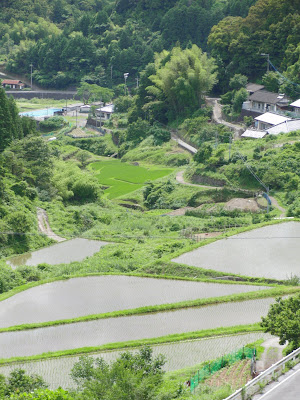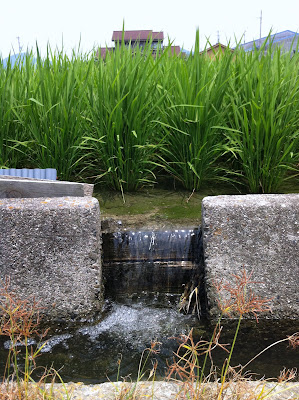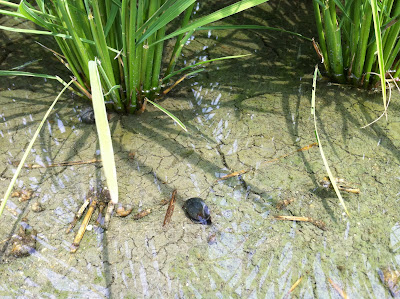June
In Japanese 'rice' is used as one of the words for 'a meal'.
In Japanese 'rice' is used as one of the words for 'a meal'.
In June, everyone outside the city who owns some land is involved in planting rice. A variety of machinery is brought out of storage - tractors, 4-wheel planting machines, and old labour-intensive 2-wheel machines. Particularly diligent farmers will also hand plant seedlings where the machines leave spaces.
For days, the village roads are caked in mud from the wheels of the machines.
Because the fields must be flooded at the same time in a cooperative operation, the planting of the rice takes place generally over just a single weekend. Some Japanese people like to claim that this requirement for cooperation as the source of the 'wet' and 'sticky' characteristics of Japanese society, which are naturally touted as virtues.
For days, the village roads are caked in mud from the wheels of the machines.
Because the fields must be flooded at the same time in a cooperative operation, the planting of the rice takes place generally over just a single weekend. Some Japanese people like to claim that this requirement for cooperation as the source of the 'wet' and 'sticky' characteristics of Japanese society, which are naturally touted as virtues.


From seed (foreground) to seedlings (middle) to paddy (back)

Trays of seedlings are mounted on the rice planter

The flooded fields are full of frogs and insects which attract birds
For a few days, the whole landscape reflects the sky
Frog croaking
After the rice is planted, the farmers of some regions hold a ceremony called 'okomori'. The producers and consumers of rice visit the shrine in the afternoon. The village headman announces to the local god that the rice has been planted, and the Shinto priest calls for everybody to be blessed with a good harvest. Afterwards, everybody adjourns to the village meeting house, enjoys a civilized boxed dinner and gets quite thoroughly intoxicated.
July / August
During the hottest, driest months of July and August, the rice grows at a rapid rate. The plants are an amazing vivid green.
The main task for the farmer is maintaining the right water conditions in the paddy. This involves constant adjustment using the wooden boards inserted in grooves in the irrigation ditches that run between the paddies. Sometimes the paddy is drained completely to kill off pests like the 'taneshi' snails that damage the growing stems and leaves. Most farmers also use some weed-killer during this time.
Pink clumps of snail eggs cling to every sort of surface
The snails are much in evidence
Green fields of rice stretch to the horizon
When the rice flowers, those who are allergic to rice pollen suffer agonies of hay fever, but those who are immune can enjoy the rich, nutty aroma which hangs in the hot summer air over the paddies. Small flies also rise up from the water and buzz about in clouds. Anyone riding a bike between the fields gets their eyes and ears filled with the tiny insects. Squadrons of dragonflies cut this way and that scooping up the flies.
Typhoons often occur in August, and the wind an rain can flatten a whole field of rice that was looking promising. Often, only a single paddy in a whole block will be savaged by the wind, leaving the surrounding fields untouched, in a strange form of 'ijime' or persecution by Nature.
September
When the stems are fully grown in September, the heads of rice begin to mature. The green fields take on a yellowy colour. If the farmer has not been assiduous enough with the weed-killer, tall grasses begin to poke out above the rice, which bends over with the weight of the rice heads.
September is the time for fumigating the rice with pesticide. The farmers, usually a husband and wife, or father and son form a team, one with a motor-driven air pump on his back attached to a long tube with holes in it. This is stretched across the paddy and held by the wife or son. When the engine is switched on, the white chemical powder pours into the tube which floats over the field, delivering death onto the insect life beneath it. The tube is marched up the field for full coverage. A good deal of the powder blows away onto other fields.
Farmers are always keeping an eye on their rice, as an evening stroll with the wife and dog is as good a time as any to do a bit of irrigation management.
When the rice begins to ripen, it becomes attractive to wild boar which live in woodland very close to human habitation. At night, the boar enter the paddies and eat as much as they can. Farmers do what they can to fence off their fields, sometimes planting flashing lights and leaving radios on all night on a fencepost. It can be unnerving going for a walk on a summer night and hearing voices from the fields. But not quite as blood-curdling as hearing a deep grunt of surprise and annoyance just a few feet away.
In late September, the banks between the paddies sprout with bright red plants known as 'higanbana' or red-hot pokers.
'Shiro sagi' or egrets take a great interest in the variety of shrimp and frogs which are still abundant.
In September, farmers who planted early are ready to harvest. This little walled compound near Tsubaki Shrine is surrounded by its own rice fields and fig orchards.

October
In October, not only the heads but also the leaves of the rice plants start to turn yellow. Where the banks between the paddies are the old earthen type as opposed to concrete, there's a vivid contrast between the yellow of the rice and the green banks.
October is the month when lowland farmers harvest the rice. When farmers are producing rice for their own consumption, they tend to hang the rice in bales so that the nutrition from the stalks continues to accumulate in the seeds. This is said to make a considerable difference, hence the effort that goes into it.
With rice for general consumption, the combine harvester is set to bag the rice directly.
When the rice has been harvested, the landscape takes on the dun colour of winter that it retains until the spring.
The new rice (shin-mai) is regarded as a precious commodity, and consumers try to time their purchase of rice to avoid the tail end of last season's rice.
In October, not only the heads but also the leaves of the rice plants start to turn yellow. Where the banks between the paddies are the old earthen type as opposed to concrete, there's a vivid contrast between the yellow of the rice and the green banks.
October is the month when lowland farmers harvest the rice. When farmers are producing rice for their own consumption, they tend to hang the rice in bales so that the nutrition from the stalks continues to accumulate in the seeds. This is said to make a considerable difference, hence the effort that goes into it.
With rice for general consumption, the combine harvester is set to bag the rice directly.
When the rice has been harvested, the landscape takes on the dun colour of winter that it retains until the spring.
The new rice (shin-mai) is regarded as a precious commodity, and consumers try to time their purchase of rice to avoid the tail end of last season's rice.






































No comments:
Post a Comment